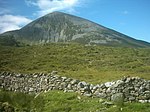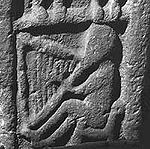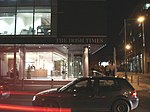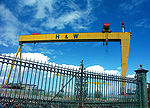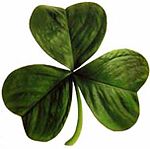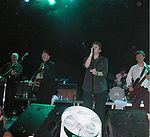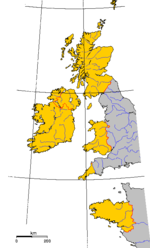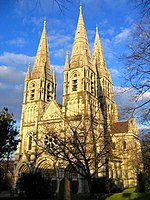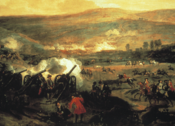Portal:Ireland/Selected article archive
Selected article archive
Selected article archive
Some of these articles about Ireland are ![]() featured articles or featured list and some are
featured articles or featured list and some are ![]() Good articles appearing on the Ireland Portal.
Good articles appearing on the Ireland Portal.
Portal:Ireland/Selected article archive/1
Croagh Patrick (Irish: Cruach Phádraig) is a 764 m (2,510 ft) mountain in the west of Ireland and an important site of pilgrimage. It is located 8 km (5 miles) from Westport, County Mayo above the villages of Murrisk and Lecanvey. On "Reek Sunday", the last Sunday in July every year, over 25,000 pilgrims climb the mountain, many of whom climb barefoot. The mountain forms the south part of a U-shaped valley created by a glacier flowing into Clew Bay in the last Ice Age. Croagh Patrick is part of a longer east-west ridge; to the west is the mountain Ben Goram. Croagh Patrick derives its name from the Irish Cruach Phádraig ("Saint Patrick's mountain") although it is known locally as the Reek, and some mistakenly refer to the place as Mount Coagh (or Croach) Patrick. In the Annals of Ulster entry for the year 1113, the mountain is named Cruachán Aigle (Eagle Mountain).
A seam of gold was discovered in the mountain in the 1980's: overall grades of 0.5 ounces of gold per ton in at least 12 quartz veins, which could produce 700,000 tons of ore. Local authorities elected not to mine it, deciding that the gold was "fine where it was". Read more...Portal:Ireland/Selected article archive/2
The Ireland rugby union team, represents both the Republic of Ireland and Northern Ireland in rugby union, a popular sport throughout Ireland although the dominant one only in limited geographical areas. Ireland compete annually in the Six Nations Championship (which they have won ten times outright and of which they have shared the championship eight times) and in the Rugby World Cup every four years where they have been eliminated at the quarter-final stage in all but one competition. They also form a quarter of the British and Irish Lions.
Historically, Ireland have been the best of the rugby union home nations, although they have just a single Grand Slam to their name in 1948 and a regular recipient of the wooden spoon in the Six Nations' predecessor tournaments. However, Irish rugby union is widely acknowledged to have made the transition to professionalism more successfully than other middle-ranking rugby powers and Ireland have churned out good results, especially for a nation with a population of only four million with strong competition for players with Gaelic Games and soccer. They have won three Triple Crowns in the last four years. Read more...Portal:Ireland/Selected article archive/3
The Irish Conservative Party, often called the Irish Tories, was one of the dominant Irish political parties in Ireland in the 19th century. Throughout much of the century it, and the Irish Liberal Party, battled for electoral dominance among Ireland's small electorate, with various parties such as the movements of Daniel O'Connell and later the Independent Irish Party relegated into third place. As late as 1859, the Irish Conservative Party still won the majority of Irish seats in Westminster, in that year's general election.
Though aligned with the Conservative Party in Great Britain, the Irish Conservatives took independent stances on many issues, a fact made easier by the lack of rigid party voting in the British House of Commons. Read more...Portal:Ireland/Selected article archive/4
Skellig Michael (from Sceilig Mhichíl in the Irish language, meaning Michael's rock), also known as Great Skellig, is a steep rocky island about 15 kilometres west of the coast of County Kerry, Ireland. It is the larger of the two Skellig Islands. For 600 years the island was an important centre of monastic life for Irish Christian monks. An Irish Celtic monastery, which is situated almost at the summit of the 230-metre-high rock, was built in 588, and became a UNESCO World Heritage Site in 1996. It is one of Europe's better known but least accessible monasteries.
Since the extreme remoteness of Skellig Michael has until recently discouraged visitors, the site is exceptionally well preserved. The very spartan conditions inside the monastery illustrate the ascetic lifestyle practiced by early Irish Christians. The monks lived in stone 'beehive' huts (clochans), perched above nearly vertical cliff walls. Read more...Portal:Ireland/Selected article archive/5
The Clàrsach (Gd.) or Cláirseach (Ga.) is the name given to the wire-strung harp of either Scotland or Ireland. The word was originally cruit, but clàrsach begins to make its appearance in the sources by the end of the 14th century.
The earliest descriptions of a European triangular framed harp i.e. harps with a fore pillar are found on 8th century Pictish stones. Pictish harps were strung from horsehair. The instruments apparently spread south to the Anglo Saxons who commonly used gut strings and then west to the Gaels of the Highlands and to Ireland. Historically the carvings were made in the period after the establishment of the Gaelic kingdom of Dál Riata. Despite the lack of direct evidence, some argue for a Gaelic influence. However, there are only thirteen depictions of any triangular chordophone from pre-11th century Europe, and twelve of them come from Scotland. Moreover, the earliest Irish word for a harp is in fact Cruit, a word which strongly suggests a Pictish provenance for the instrument.
One study suggests Pictish stone carvings may be copied from the Utrecht Psalter, the only other source outside Pictish Scotland to display a Triangular Chordophone instrument. The Utrecht Psalter was penned between 816-835 A.D. While Pictish Triangular Chordophone carvings found on the Nigg Stone dates from 799 A.D. and pre-dates the document by up to thirty-five years. Read more...Portal:Ireland/Selected article archive/6
Ireland national football team was the national association football team that represented Ireland from 1882 until 1950. The team was organised by the Irish Football Association, formed in 1880 in Belfast to organise football throughout the island of Ireland. Together with England, Scotland and Wales, they competed regularly in the British Home Championship. In 1914 Ireland were British Champions and in 1950 they played in the qualifying rounds of the World Cup.
After 1921 the right of the IFA to field an all-Ireland team was challenged by the rival Dublin - based Football Association of Ireland when it began organising its own national team. In subsequent years there were in effect two Ireland teams. Both the IFA and FAI claimed jurisdiction over the whole of Ireland and selected players from the whole island. The situation remained unresolved until 1950 when both teams entered the qualifying rounds of the 1950 FIFA World Cup - the first time the two teams had competed in the same competition. As a result several players found themselves playing for two national teams in the same competition. FIFA intervened and decreed that for future World Cups, the IFA team would compete as Northern Ireland, while the FAI team would be officially known as the Republic of Ireland. Read more...Portal:Ireland/Selected article archive/7
The bodhrán (IPA [ˈbɔːrɑːn] or [ˈbaʊrɑːn]; plural bodhráns or bodhráin) is an Irish frame drum ranging from 25 to 65cm (10" to 26") in diameter, with most drums measuring 35 to 45cm (14" to 18"). The sides of the drum are 9 to 20cm (3½" to 8") deep. A goatskin head is tacked to one side (although nowadays, synthetic heads, or new materials like kangaroo skin, are sometimes used). The other side is open ended for one hand to be placed against the inside of the drum head to control the pitch and timbre. One or two crossbars, sometimes removable, may be inside the frame, but this is increasingly rare on professional instruments. Some professional modern bodhráin integrate mechanical tuning systems similar to those used on drums found in drum kits. Read more...
Portal:Ireland/Selected article archive/8
The executions during the Irish Civil War took place during the guerrilla phase of the Irish Civil War (October 1922 – May 1923) This phase of the war was bitter and both sides, the Government forces of the Irish Free State and the Anti-Treaty IRA insurgents, used executions and terror in what developed into a cycle of atrocities. From November 1922, the Free State government embarked on a concerted policy of executing Republican prisoners in order to bring the war to an end. Many of those killed had previously been allies and in some cases close friends (during the Irish War of Independence 1919–1921), of those who ordered their deaths in the civil war. In addition, government troops summarily killed prisoners in the field on several occasions. The executions of prisoners left a lasting legacy of bitterness in Irish politics.
The use of execution by the Irish Free State in the civil war was relatively harsh. By contrast with their 77 official executions, the British had executed only 14 IRA volunteers during the War of Independence. One of the reasons for the draconian Free State policy from October 1922 was the death of Michael Collins, the commander of Free State forces in an ambush on 22 August. Whereas Collins had hoped for a speedy reconciliation of the warring Irish nationalist factions, after his death the Free State government, led by W. T. Cosgrave, Richard Mulcahy and Kevin O'Higgins, took the position that the anti-Treaty IRA were conducting an unlawful rebellion against the legitimate Irish government and should be treated as criminals rather than as combatants. O'Higgins in particular voiced the opinion that the use of terror was the only way to bring the war to an end. Read more...Portal:Ireland/Selected article archive/9
Derry or Londonderry (Doire or Doire Cholm Chille in Irish), often called the Maiden City, is a city in Northern Ireland. The old walled city of Londonderry lies on the west bank of the River Foyle, and the present city now covers both banks (Cityside to the west and Waterside to the east) and is connected by two bridges. The district extends to rural areas to the southeast of the city. The population of the city proper was 83,652 in the 2001 Census. The Derry Urban Area (including Culmore, New Buildings and Strathfoyle) had a population of 90,663, and is the second-largest city in Northern Ireland, the fourth on the island of Ireland. It is one of the only places in Europe not to have its defensive walls breached (though the original fortified gates have been replaced).
Derry is very near the border with County Donegal in the Republic of Ireland and also serves the west of County Londonderry. The district is run by Derry City Council and has an airport, City of Derry Airport, and a seaport, Londonderry Port. The City of Derry has had a very close relationship with what is now County Donegal for centuries. The person traditionally seen as the "founder" of Derry is St. Columba (also known as Colm Cille or St. Columb), a holy man and royal prince from Tír Chonaill, the old name for almost all of modern County Donegal. Indeed, Derry was often seen as being part of Tír Chonaill before 1600. Today, most of the Catholic population of the City of Derry would be of Donegal descent. Read more...Portal:Ireland/Selected article archive/10
The Burren (Irish: Boireann, meaning 'Great rock', Boirinn is the modern form used by the Ordnance Survey) is a unique karst-landscape region in northwest County Clare, in Ireland. The region measures approximately 250 square kilometres and is enclosed roughly within the circle comprised by the villages Ballyvaughan, Kinvara, Tubber, Corofin, Kilfenora and Lisdoonvarna, It is bounded by the Atlantic and Galway Bay on the west and north respectively. Strictly speaking the territory of the Burren or barony of Burren only contains the villages of Lisdoonvarna, Ballyvaughan, Fanore, Craggagh, New Quay/Burrin, Bealaclugga (Bellharbour) and Carron.
The definite article (making it "the Burren") has only been added to the name in the last few decades, possibly by academics, as it had always been called Boireann in Irish and Burren in English. Read more...Portal:Ireland/Selected article archive/11
The British–Irish Council is a body created by the Belfast Agreement in 1998, and formally established on 2 December 1999 on the entry into force of the consequent legislation. Its membership includes representatives from the governments of the Republic of Ireland; the United Kingdom and three of its constituent countries: Northern Ireland, Scotland and Wales; and the three Crown Dependencies: Guernsey, Jersey and the Isle of Man. Its stated aim is to "promote the harmonious and mutually beneficial development of the totality of relationships among the peoples of these islands". Read more...
Portal:Ireland/Selected article archive/12
The Orange Institution, more commonly known as the Orange Order or the Orange Lodge, is a Protestant fraternal organisation based predominantly in Northern Ireland and Scotland with lodges throughout the Commonwealth and the United States. It was founded in Loughgall, County Armagh, Ireland in 1795; its name is a tribute to Dutch-born Protestant king of England, William III, of the House of Orange-Nassau. William had defeated the Catholic army of James II at the Battle of the Boyne in 1690. Observers have accused the Orange Institution of being a sectarian organisation, due to its goals and exclusion of Roman Catholics as members. Read more...
Portal:Ireland/Selected article archive/13
The Irish Times is an Irish daily broadsheet news paper launched in the late 1850s. The current editor is Geraldine Kennedy, who succeeded Conor Brady in 2002. The paper is generally perceived as liberal and neutral on Irish unity, in contrast to the Irish Independent, which is perceived as populist and economically right wing.
Though formed as a Protestant Irish nationalist paper, within two decades, and under new owners, it had become the voice of Irish unionists who wanted Ireland to remain a full part of Britain. In the early twentieth century, as the Irish Free State seceded from the United Kingdom and later also the Commonwealth, the paper changed its identity, becoming a more radical voice in the Irish media.
Today, its most prominent columnists include writer and arts commentator Fintan O'Toole, the satirist Miriam Lord and former taoiseach (Irish prime minister) Garret FitzGerald. Senior international figures, including Tony Blair, Bill Clinton and others have written for its 'Op-Ed' (Opinion and Editorial) page. Among of its most prominent columns include Drapier (an anonymous column produced weekly by a politician, giving the 'insider' view of politics).
It is also the Irish newspaper with the most bureaux abroad; it has had full time correspondents in Washington, Moscow, Beijing, London, Central and South America, Africa and other parts of the world. According to the Audit Bureau of Circulations, it had a daily circulation of 117,370 during the second six months of 2005. Read more...Portal:Ireland/Selected article archive/14
Harland and Wolff Heavy Industries is a heavy industries and shipbuilders located in Belfast, Northern Ireland. Formed in 1861 by Edward James Harland (1831–1895) and Hamburg-born Gustav Wilhelm Wolff (1834–1913, in the UK from age 14), Harland had bought the small shipyard on Queen's Island, in which he was employed as general manager in 1858. The shipyard has built many types of ships continuously since then, the most famous being the RMS Titanic. Their main business today is ship repair and conversion work, ship design and bridge building. Harland and Wolff also owns the world's largest dry dock, which is in Belfast. Belfast's skyline is still dominated today by Harland and Wolff's famous twin cranes Samson and Goliath, built in 1974 and 1969 respectively.
The company was nationalised in 1977 but subsequently bought back from the British government in 1989 in a management/employee buy-out in partnership with the Norwegian shipping magnate Fred Olsen, leading to a new company called Harland and Wolff Holdings Plc. Faced with competitive pressures (especially as regards shipbuilding), Harland and Wolff have sought to shift and broaden their portfolio, focus less on shipbuilding and more on design and structural engineering, as well as ship repair, offshore construction projects and competing for other projects to do with metal engineering and construction. This led to Harland and Wolff constructing a series of bridges in Britain and also in the Republic of Ireland. Read more...Portal:Ireland/Selected article archive/15
Brú na Bóinne (English: Palace of the Boyne) is an internationally important complex of Neolithic chamber tombs, standing stones, henges and other prehistoric enclosures located in a wide meander of the River Boyne in Ireland. Later, it was used for Iron Age burials. The Normans settled the area in the Middle Ages and in 1690 it was the site of the famous Battle of the Boyne. The site is often referred to as the "Bend of the Boyne", and this is often (incorrectly) taken to be a translation of Brú na Bóinne. It is a World Heritage Site, containing what have been described as the national monuments of Ireland.
The site covers 780ha and contains around 40 passage tombs as well as other prehistoric sites and later features. The majority of the monuments are concentrated on the north side of the river. The most well-known sites within Brú na Bóinne are the impressive passage graves of Newgrange, Knowth and Dowth all famous for their significant collections of megalithic art. Each stands on a ridge within the river bend and two of the tombs, Knowth and Newgrange appear to contain stones re-used from an earlier monument at the site. There is no in situ evidence for earlier activity at the site however save for the spotfinds of flint tools left by Mesolithic hunters. Read more...Portal:Ireland/Selected article archive/16
The shamrock, a symbol of the whole of Ireland and a registered trademark of the Republic of Ireland, is a three-leafed old white clover, sometimes (rarely nowadays) Trifolium repens (white clover, known in Irish as seamair bhán) but more usually today Trifolium dubium (lesser clover, Irish: seamair bhuí). The diminutive version of the Irish word for "clover" ("seamair") is "seamaróg", which was anglicised as "shamrock", representing a close approximation of the original Gaelic pronunciation. However, other three-leafed plants — such as black medic (Medicago lupulina), red clover (Trifolium pratense), and Common wood sorrel (genus Oxalis) — are sometimes designated as shamrocks. The shamrock was traditionally used for its medical properties and was a popular motif in Victorian times. It is also a common way to represent St. Patrick's Day, a holiday celebrated on March 17th. Shamrocks are said to bring good luck.. Read more...
Portal:Ireland/Selected article archive/17
Fairytale of New York is a popular Christmas song by Irish folk-rock group The Pogues, and featuring the British singer Kirsty MacColl. The song is an Irish folk style ballad, written by Jem Finer and Shane MacGowan, and featured on The Pogues' album If I Should Fall from Grace with God. The song features string arrangements by Fiachra Trench. It is frequently voted the Number 1 Christmas song of all time in various television, radio and magazine related polls. Read more...
Portal:Ireland/Selected article archive/18
'Modern Celts are peoples who consider themselves, or have been considered by others, to be Celts in modern times i.e. post 1800. However, the term is generally used for a number of peoples in Europe sharing various cultural traits and speaking Indo-European languages with a common Proto-Celtic origin. Since the Enlightenment, the term Celtic has been applied to a wide variety of peoples and cultural traits present and past. Today, Celtic is often used in order to describe the people and their respective cultures and languages of several ethnic groups in Ireland, France, Wales, Scotland, Cornwall, parts of northern Spain and northern Portugal (the Celtic nations). Read more...
Portal:Ireland/Selected article archive/19
Saint Finbarre's Cathedral, also spelled Saint Fin Barre's Cathedral (Irish: Ardeaglais Naomh Fionnbarra) is a Church of Ireland cathedral located in Cork city, Ireland. The site of the cathedral has been a place of worship since the 7th century. The three spires of the cathedral are one of Cork's main landmarks. It is the seat of the Bishop of Cork, Cloyne and Ross, currently Bishop Paul Colton and is named after Cork's patron saint.
A medieval Cathedral was situated on the site prior to the 18th Century one but few traces of it are visible. This cathedral was damaged during the siege of Cork in 1689/90 when it came under fire from the nearby Elizabeth Fort. When the steeple was demolished in 1865 a 24-pound cannon was discovered, which now is on display in the current building. Read more...Portal:Ireland/Selected article archive/20
The Battle of the Boyne (Irish: Cath na Bóinne) was a turning point in the Williamite claim on the English throne. The deposed King James VII of Scotland and James II of England and Ireland and his Jacobite supporters were defeated by James' nephew and son-in-law, William III and his supporters. By the invitation of Parliament, William had deposed James in 1688. Both kings acted as commander of their respective armies.
The battle took place on July 1, 1690 (OS) just outside the town of Drogheda on Ireland's east coast. Each army stood on opposing sides of the River Boyne. William's forces easily defeated those of James who led an army of mostly raw recruits. The symbolic importance of this battle has made it one of the best-known battles in British and Irish history and a key part in Irish Protestant folklore. It is still commemorated today, principally by the Orange Institution. As a consequence of the adoption of the Gregorian calendar, the battle is now commemorated on July 12 each year. Read more...Portal:Ireland/Selected article archive/21
Ryanair (ISEQ: RYA LSE: RYA NASDAQ: RYAAY) is an airline based in Ireland. It is Europe's largest low-cost carrier, operating 270 low-fare routes to 21 European countries. Over the years it has evolved into the world's most profitable airline [1], running at remarkable margins by relentlessly driving costs down, for example, Ryanair has banned staff charging their personal mobile phones on company premises - to save electricity costs. Ryanair has been characterised by rapid and continuing expansion, enabled by the deregulation of the air industry in Europe in 1997. Read more...
Portal:Ireland/Selected article archive/22

Portal:Ireland/Selected article archive/23
The history of Irish poetry includes the poetries of two languages, one in Irish and the other in English. The complex interplay between these two traditions, and between both of them and other poetries in English, has produced a body of work that is both rich in variety and difficult to categorise.
Towards the last quarter of the 20th century, modern Irish poetry has tended to a wide range of diversity, from the poets of the Northern school to writers influenced by the modernist tradition and those facing the new questions posed by an increasingly urban and cosmopolitan society. Read more...Portal:Ireland/Selected article archive/24
The Economy of the Republic of Ireland is modern, relatively small, and trade-dependent with growth averaging a robust 10% in 1995–2000. Agriculture, once the most important sector, is now dwarfed by industry, which accounts for 46% of GDP, about 80% of exports, and employs 29% of the labour force. Although exports remain the primary engine for the Republic's robust growth, the economy is also benefiting from a rise in consumer spending and recovery in both construction and business investment. Read more...



The geography of Ireland describes an island in northwest Europe in the North Atlantic Ocean. The main geographical features of Ireland include low central plains surrounded by a ring of coastal mountains. The highest peak is Carrauntoohil (Irish: Corrán Tuathail), which is 1,041 m (3,414 ft) above sea level. The western coastline is rugged, with many islands, peninsulas, and headlands. The island is bisected by the River Shannon, which at 259 km (161 s) with a 113 km (70 miles) estuary is the longest river in Ireland and flows south from County Cavan in the north to meet the Atlantic just south of Limerick. There are a number of sizable lakes along Ireland's rivers, with Lough Neagh being the largest.
Politically the island consists of the state Ireland and the UK constituent country Northern Ireland. Located west of the island of Great Britain, it is located at approximately 53°N 8°W / 53°N 8°W. It has a total area of 84,412 km² (32,591 mile²). It is separated from Britain by the Irish Sea and from mainland Europe by the Celtic Sea. Read more...
The 1981 Irish hunger strike was the culmination of a five-year protest during The Troubles by Irish republican prisoners in Northern Ireland. The protest began as the blanket protest in 1976, when the British government withdrew Special Category Status for convicted paramilitary prisoners. In 1978, after a number of attacks on prisoners leaving their cells to "slop out", the dispute escalated into the dirty protest, where prisoners refused to wash and covered the walls of their cells with excrement. In 1980 seven prisoners participated in the first hunger strike, which ended after 53 days.
The second hunger strike took place in 1981 and was a showdown between the prisoners and the British Prime Minister, Margaret Thatcher. One hunger striker, Bobby Sands, was elected as a Member of Parliament during the strike, prompting media interest from around the world. The strike was called off after ten prisoners had starved themselves to death–including Sands, whose funeral was attended by 100,000 people. The strike radicalised nationalist politics, and was the driving force that enabled Sinn Féin to become a mainstream political party. Read more...
The postage stamps of Ireland are issued by the postal authority of the independent Irish state. Ireland was part of the United Kingdom of Great Britain and Ireland when the world's first postage stamps were issued in 1840. These stamps, and all subsequent British issues, were used in Ireland until the new Irish Government assumed power in 1922. Beginning on 17 February 1922, existing British stamps were overprinted with Irish text to provide some definitives until separate Irish issues became available. Following the overprints, a regular series of definitive stamps was produced by the new Department of Posts and Telegraphs, using domestic designs. These definitives were issued on 6 December 1922; the first was a 2d stamp, depicting a map of Ireland (including Northern Ireland, which remained a part of the United Kingdom). Since then new images, and additional values as needed, have produced a total of nine series of definitives.
These were the major stamp productions for everyday use. Commemorative stamps first appeared in 1929, and these now appear several times a year, celebrating many aspects of Irish life, such as notable events and anniversaries, Irish life and culture, and many famous Irish people. Some definitive and commemorative stamps have been produced in miniature sheet, booklet and coil configurations in addition to the common sheet layout. Postage dues and airmails complete the stamp issues of the two, sequential, Irish stamp-issuing authorities. Two styles of watermark were used though the overprinted issues came with the watermarks of the British stamps provided for overprinting by the British Post Office.
Oifig an Phoist, the Irish Post Office, was the section of The Department of Posts and Telegraphs which issued all Irish stamps up to 1984. After the division of the Department of Posts and Telegraphs into two semi-state organisations in 1984, An Post took over the responsibility for all Irish postal services including the issuing of postage stamps. Read more...Portal:Ireland/Selected article archive/29
Áras an Uachtaráin (Irish pronunciation: [ˈaːɾˠəsˠ ənˠ ˈuəxt̪ˠəɾˠaːnʲ]; translates simply to "Residence of the President"), formerly the Viceregal Lodge, is the official residence of the President of Ireland. It is located in the Phoenix Park on the Northside of Dublin.
The original house was designed by park ranger and amateur architect, Nathaniel Clements in the mid eighteenth century. It was bought by the administration of the British Lord Lieutenant of Ireland to become his summer residence in the 1780s. His official residence was in the Viceregal Apartments in Dublin Castle. The house in the park later became the Viceregal Lodge, the "out of season" residence of the Lord Lieutenant (also known as the Viceroy), where he lived for most of the year from the 1820s onwards. During the Social Season (January to St. Patrick's Day in March) he lived in state in Dublin Castle.
Some historians have claimed that the garden front portico of Áras an Uachtaráin (which can be seen by the public from the main road through the Phoenix Park) was used as a model by the Irish architect who designed the White House. However the portico was built after he had left for the United States. (There is better evidence he used Leinster House as a model.) Read more...Portal:Ireland/Selected article archive/30
Irish dances can broadly be divided into social dance and performance dances. Irish social dancing can be divided further into céilí and set dancing. Irish set and céilí dances are usually danced by formations (sets) of couples, often in squares of four couples, also called a four hand. Irish social dance is a living tradition, and variations in particular dances are found across the Irish dance community; in some places, dances are deliberately modified and new dances are choreographed.
Irish performance dancing is traditionally referred to as stepdance. Irish stepdance, popularized in 1994 by the world-famous show "Riverdance," is notable for its rapid leg movements, body and arms being kept largely stationary. Most competitive stepdances are solo dances, though many stepdancers also perform and compete using traditional set and céilí dances. The solo stepdance is generally characterized by a controlled but not rigid upper body, straight arms, and quick, precise movements of the feet.
The dancing traditions of Ireland probably grew in close association with Irish traditional music. Originating in Pre-Christian Ireland, Irish dance was later influenced by dance forms from the Continent, especially the Quadrille. Travelling dancing masters taught all over Ireland as late as the early 1900s. Read more...Portal:Ireland/Selected article archive/31
Queen's University Belfast is a university in Belfast, Northern Ireland. The university's official title, per its charter, is Queen's University of Belfast. It is often referred to simply as Queen's, or by the abbreviation QUB. It is one of two universities in Northern Ireland, the other being the University of Ulster. The university was chartered in 1845, and opened in 1849, as Queen's College, Belfast, but has roots going back to 1810 and the Belfast Academical Institution.
Queen's is a member of the Russell Group (a lobby group of major research universities in the United Kingdom). The university offers academic degrees at various levels and across a broad subject range, with over 300 degree programmes available. Its School of Medicine and Dentistry is the only medical school in Northern Ireland. The university's current President and Vice-Chancellor is Professor Peter Gregson, and its Chancellor is the former United States Senator, George Mitchell.
The University also forms the focal point of the Queen's Quarter area of the city, one of Belfast's four cultural districts. Read more...Portal:Ireland/Selected article archive/32
Irish whiskey (Irish: Fuisce or Uisce beatha) is a whiskey made in Ireland. There are several types of whiskey common to Ireland: Single Malt, Single Grain, Pure Pot Still and Blended Whiskey. The word whiskey is an Anglicisation of the ancient Gaelic term "uisce beatha" which translates as "water of life". (The Craythur is a modern Irish term for whiskey, from 'the creature', as in 'created'...)
At one time, all whisky was spelled without the extra 'e', as "whisky". In around 1870, the reputation of Scottish whisky was very poor as Scottish distilleries flooded the market with cheaper spirits produced using the Coffey still. The Irish and American distilleries adopted the spelling "whiskey", with the extra "e", to distinguish their higher quality product. Today, the spelling whisky (plural whiskies) is generally used for whiskies distilled in Scotland, Wales, Canada, Australia and Japan, while whiskey is used for the spirits distilled in Ireland and America.
Traditional Irish whiskey was distilled from a mash of mixed malted and unmalted grains whereas Scotch is either distilled exclusively from malted grain (hence "single malt"), or from unmalted grain. Today, most Irish whiskey is blended from a mixture of pot still whiskey and cheaper grain whiskey. Bushmills, however, is an exception, as it produces no Irish-style pot-still whiskey.
Most Irish whiskey is distilled three times, but so is some Scotch; thus it is a myth, although a common one, that this is the main distinction between the two varieties. Irish whiskey also differs in that peat is almost never used in the malting process, so the smoky, earthy overtones common to Scotches (particularly Islay Scotches) are not present except for the Connemara Peated Irish Malt whiskey from the Cooley distillery. Although Scotland sustains approximately 90 distilleries, Ireland has only three producing a number of different whiskeys. Read more...Portal:Ireland/Selected article archive/33
The Great Hunger (Irish: An Gorta Mór or An Drochshaol, litt: The Bad life) is a highly contentious period of history between 1845 and 1852 during which the population of Ireland was reduced by 20 to 25 percent. It is known by various names, such as The Great Famine in Ireland itself and The Irish Potato Famine internationally. The proximate cause of the famine was a pathogenic water mould, Phytophthora infestans, the disease it causes is commonly known as late blight of potato. Though P. infestans ravaged potato crops throughout Europe during the 1840s, its human cost in Ireland was exacerbated by a host of political, social, economic, and climatological factors which remain the subjects of heated historical debate.
The famine was a watershed in the history of Ireland. Its effects extended well beyond its immediate demographic impact and permanently changed the island's political and cultural landscape. For both the native Irish and those in the resulting diaspora, the famine entered folk memory and became a rallying point for various nationalist movements. Virtually all modern historians of Ireland regard it as a dividing line in the Irish historical narrative, referring to the preceding period of Irish history as "pre-Famine." Read more...Portal:Ireland/Selected article archive/34
Gaelic football (Irish: Peil, Peil Ghaelach, or Caid), commonly referred to as "football", "Gaelic", or "Gah" is a form of football played mainly in Ireland. It is, together with hurling, one of the two most popular spectator sports in Ireland today.
Gaelic football is played by teams of 15 on a rectangular grass pitch with H-shaped goals at each end. The primary object is to score by kicking/striking the ball with your hand and getting it through the goals. The team with the highest score at the end of the match wins.
Players advance the ball up the field with a combination of carrying, soloing (dropping and then toe-kicking the ball upward into the hands), kicking, and hand-passing to their team-mates.
Football is one of four Gaelic games run by the Gaelic Athletic Association, the largest sporting organization in Ireland. It has strict rules on player amateurism and the pinnacle of the sport is the inter-county All-Ireland Football Final. The game is believed to have descended from ancient Irish football known as caid which dates back to medieval times, although the modern rules were not set down until 1887. Read more...
Sunday Bloody Sunday is the opening track and third single from U2's 1983 album, War. The song is noted for its militaristic drumbeat, simple but harsh guitar, and melodic harmonies. One of U2's most overtly political songs, its lyrics describe the horror felt by an observer of The Troubles in Northern Ireland.
The single was released in March 1983 in Germany and The Netherlands only; "Two Hearts Beat As One" was released instead in other territories. Along with "New Year's Day", the song helped U2 reach a wider listening audience. It was generally well-received by critics on the album's release.
The song has remained a staple of U2's live concerts. During its earliest performances, the song created controversy. Bono reasserted the song's anti-hate, anti-sectarian-violence message to his audience for many years. Today, it is considered one of U2's signature songs, being one of the band's most performed songs. Critics rate it among the best political protest songs, and it has been covered by over a dozen artists. It was named the 268th greatest song by Rolling Stone on their list of the 500 Greatest Songs of All Time. Read more...
In Irish mythology, a leprechaun (Irish: leipreachán) is a type of male faerie said to inhabit the island of Ireland. They are a class of "faerie folk" associated in Irish mythology and folklore, as with all faeries, with the Tuatha Dé Danann and other quasi-historical peoples said to have inhabited Ireland before the arrival of the Celts.
Leprechauns and other creatures of Irish mythology are often associated with "faerie forts" or "faerie rings" — often the sites of ancient (Celtic or pre-Celtic) earthworks or drumlins.
They usually take the form of old men who enjoy partaking in mischief. Their trade is that of a cobbler or shoemaker. They are said to be very rich, having many treasure crocks buried during war-time. According to legend, if anyone keeps an eye fixed upon one, he cannot escape, but the moment the gaze is withdrawn, he vanishes.
In most tales and stories leprechauns are depicted as generally harmless creatures who enjoy solitude and live in remote locations, while in others they are depicted as ill-natured and mischievous, with a mind for cunning. Opinion is divided as to if they ever enjoy the company of other spirits. Although rarely seen in social situations, leprechauns are supposedly very well spoken and, if ever spoken to, could make good conversation. Read more...
Battle of Tory Island was a naval action of the French Revolutionary Wars, fought on 12 October 1798 between French and British squadrons off the northwest coast of Donegal in Ireland. The last action of the Irish Rebellion of 1798, the Battle of Tory Island ended the final attempt by the French Navy to land substantial numbers of soldiers in Ireland during the war. It also ended the last hopes the United Irishmen had of receiving outside support in their struggle with the British.
In May 1798 the Society of United Irishmen, led by Theobald Wolfe Tone, precipitated an uprising against British rule in Ireland. At the urging of the rebels a small French force under General Humbert was landed at Killala, but by early September both this expedition and the rebellion had been defeated. Unaware of the defeat, on 16 September the French despatched reinforcements. Having missed one invasion force, the Royal Navy was on alert and when the reinforcements left Brest they were soon spotted. After a long chase, the French were brought to battle in a bay off Donegal close to Tory Island. During the action the outnumbered French attempted to escape, but were run down and defeated piecemeal, with the British capturing four ships and scattering the survivors. Of the ten ships in the original French squadron, only two frigates and a schooner reached safety. Read more...Portal:Ireland/Selected article archive/38
Aer Lingus is the flag carrier airline of Ireland founded in April 1936. Based at Dublin Airport, but originally operating out of Baldonnel Airfield, it operates 47 Airbus aircraft serving Europe, Africa and North America. The name, Aer Lingus is an anglicisation of the Irish form Aer Loingeas.
The airline is 29.4% owned by Ryanair and 25.4% owned by the Government of Ireland. It was floated on the Dublin and London Stock Exchanges on 2 October 2006, following prior government approval (the government previously owned 85% of the airline). Aer Lingus is a former member of the Oneworld airline alliance, which it left on 31 March 2007.
While Aer Lingus is not in an alliance it has codeshares with Oneworld, Star Alliance and SkyTeam members, as well as interline agreements with Aer Arann and JetBlue Airways in the United States. The company employs 4,000 people and in 2008 had revenues of €1.4 billion. Aer Lingus transferred 10 million passengers in 2008. It has a mixed business model, operating a low fare service on its European and North African routes and full service, two-class flights on transatlantic routes. Read more...
The Irish Victoria Cross recipients lists all Irish-born recipients of the Victoria Cross, the highest war honour of the British Empire and the Commonwealth of Nations. Since 1881 it has been awarded to service personnel for extraordinary valour and devotion to duty while facing a hostile force. Between 1858 and 1881 the Victoria Cross could be awarded for actions taken "under circumstances of extreme danger" not in the face of the enemy. Six people were awarded Victoria Crosses under this clause until it was amended in 1881 to only allow acts "in the presence of the enemy". It was awarded to members of the British Armed Forces which included Irish service personnel until 1922. As of April 2008, 188 recipients are listed who were born in Ireland or had full Irish parentage.
Both Catholic and Protestant officers and servicemen born in Ireland have received the honour. 30 Irish VC recipients received awards in the Crimean war, 52 Irish VCs in the Indian Mutiny, 46 Irish VCs in numerous other British Empire campaigns between 1857 to 1914, 37 Irish VCs in the First World War and eight Irishmen received VC awards for valour in the Second World War. Read more...
SS Irish Oak was a steamship chartered by Irish Shipping Limited in 1941, to transport wheat and fertilizer from North America to Ireland at a time when the country had few ships of her own. Sailing as a clearly marked neutral vessel, not in-convoy, she was torpedoed and sunk by U-607 on 15 May 1943 midway between North America and Ireland. The crew were rescued from their lifeboats by the Irish Plane about eight hours later.
At the time there were conflicting reports that she had not and allegations that she had warned a nearby convoy of the presence of a U-boat. The British nationality of her captain became an issue in the Irish general election of June 1943, there were diplomatic exchanges between the United States and the Irish Republic, and questions raised in the British House of Commons. The U-boat's captain received a mild reprimand. Read more...
Drapier's Letters is the collective name for a series of seven pamphlets written between 1724 and 1725 by Jonathan Swift to arouse public opinion in Ireland against the imposition of a privately minted copper coinage which Swift believed to be of inferior quality. William Wood was granted letters patent to mint the coin, and Swift saw the licensing of the patent as corrupt. In response, Swift represented Ireland as constitutionally and financially independent of Britain in the Drapier's Letters. Because it was a politically sensitive subject, Swift wrote under the pseudonym M. B. Drapier and the Drapier's Letters are seen as the most important of Swift's "Irish tracts."
Although the letters were condemned by the Irish government, with prompting from the British government, they inspired popular sentiment against Wood and his patent. This turned into a nationwide boycott, which forced the patent to be withdrawn; Swift was later honoured for this service to the people of Ireland. Many Irish people recognized Swift as a hero for his defiance of British control over the Irish nation. Beyond being a hero, many critics have seen Swift, through the persona of the Drapier, as the first to organize a "more universal Irish community", although it is disputed as to who constitutes that community.
The first complete collection of the Drapier's Letters appeared in the 1734 George Faulkner edition of the Works of Jonathan Swift along with an allegorical frontispiece offering praise and thanks from the Irish people. Some of Swift's other political writings are Gulliver's Travels, A Tale of a Tub, and A Modest Proposal. Read more...Portal:Ireland/Selected article archive/42
Guinness is a popular Irish dry stout that originated in the brewery of Arthur Guinness (1725–1803) at St. James's Gate, Dublin. Guinness is directly descended from the porter style that originated in London in the early 18th century and is one of the most successful beer brands worldwide, brewed in almost 50 countries and available in over 100 countries.
A distinctive feature is the burnt flavour which is derived from the use of roasted unmalted barley. For many years a portion of aged brew was blended with freshly brewed product to give a sharp lactic flavour (which was a characteristic of the original porter). Although the palate of Guinness still features a characteristic "tang", the company has refused to confirm whether this type of blending still occurs.
The thick creamy head is the result of the beer being mixed with nitrogen when being poured. It is popular with Irish people both in Ireland and abroad in spite of a decline in consumption since 2001, is still the best-selling alcoholic drink in Ireland. Read more...
The murder of Julia Martha Thomas dubbed the "Barnes Mystery" or the "Richmond Murder" by the press, was one of the most notorious crimes in late 19th-century Britain. Thomas, a widow in her 50s who lived in Richmond in southwest London, was murdered on 2 March 1879 by her maid, Kate Webster, a 30-year-old Irishwoman. Webster disposed of the body by dismembering it, boiling the flesh off the bones, and throwing most of the remains into the River Thames. Part of Thomas' remains were subsequently recovered from the river. Her severed head remained missing until October 2010, when the skull was found during building works being carried out for Sir David Attenborough.
After the murder, Webster posed as Thomas for two weeks, but was exposed and fled back to Ireland and her uncle's home at Killanne near Enniscorthy, County Wexford. She was arrested there on 29 March and was returned to London, where she stood trial in July 1879 when she was convicted and sentenced to death. She finally confessed to the murder the night before she was hanged, on 29 July, at Wandsworth Prison. The case attracted huge public interest and was widely covered by the press in Great Britain and Ireland. Webster's behaviour after the crime and during the trial further increased the notoriety of the murder. Read more...Portal:Ireland/Selected article archive/44
Irish whiskey (Irish: Fuisce or uisce beatha) is whiskey made on the island of Ireland.
The word "whiskey" is an Anglicisation of uisce beatha or uisge beatha, a phrase from the Goidelic branch of languages (Irish, Scottish Gaelic and Manx) meaning "water of life" (see aqua vitae).
Most Irish pot still whiskey is distilled three times, while most (but not all) Scotch whisky, is only distilled twice. Peat is rarely used in the malting process, so that Irish whiskey has a smoother finish as opposed to the smoky, earthy overtones common to some Scotches. There are notable exceptions to these rules in both countries; an example is Connemara peated Irish malt (double distilled), a whiskey from the Cooley Distillery in Riverstown, Cooley, County Louth.
Irish whiskey was once the most popular spirit in the world, though a long period of decline from the late 19th century onwards greatly damaged the industry. Although Scotland sustains approximately 105 distilleries, Ireland has only seven in current operation – only four of which have been operating long enough to have products sufficiently aged for current sale on the market as of 2013, and only one of which was operating before 1975. Irish whiskey has seen a great resurgence in popularity since the late twentieth century, and has been the fastest growing spirit in the world every year since 1990. Read more...Portal:Ireland/Selected article archive/45
Aibidil Gaoidheilge agus Caiticiosma ("Irish Alphabet and Catechism") is the first book printed in Ireland in the Irish language. Meant as a Protestant primer, the book was written by John Kearney (Irish: Seán Ó Cearnaigh), a treasurer of St. Patrick's Cathedral, Dublin. It includes a short section on the spelling and sounds of Irish.
The production of this book was part of a larger endeavour by Irish Protestants to print the Bible in the Irish language so that the common person could read it. The book was printed on a press which was set up in the home of Alderman John Ussher (Irish: Sheón ̧user). Ussher, who was a well-known Dublin Protestant, also paid for the venture. Though the printer's identity is unknown, it is possible that William Kearney, a nephew of John Kearney was the printer.
200 copies of the book were printed but only four known copies exist today. In 1995 a copy of the book was bought by Trinity College Library Dublin for £47,700 ($76,463) at Christie's. Read more...
